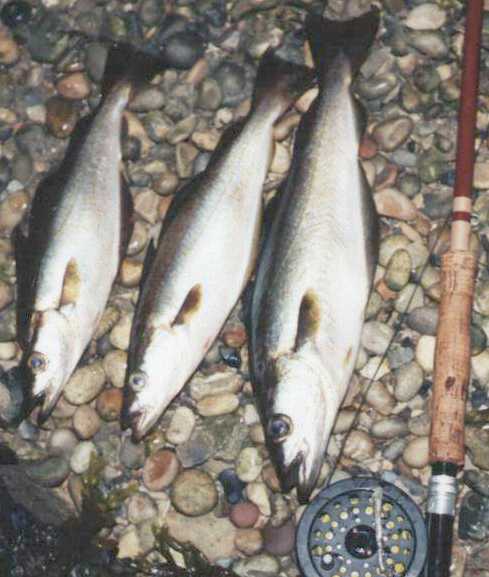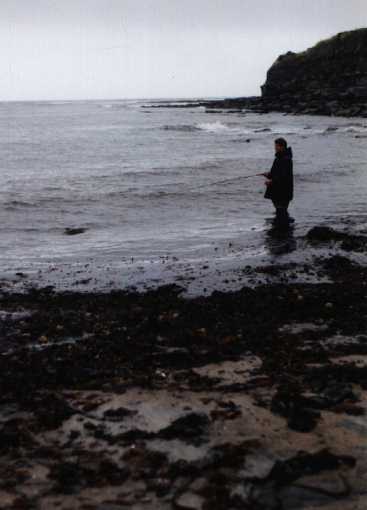Have you tried sea fly-rodding yet? Once you've got the feel of sea fishing from a sandy or rocky beach you'll be ready to try something different. The topics I've covered here aren't advanced exactly, just not suitable for a first trip.
The sea is never still. Study it, I don't necessarily mean the waves, most big lakes have waves, the sea moves differently. There's almost always a current, it's like a huge, slow, river. There are eddies, interlaced currents, holding points and pools. Unlike a river these features move, the tide rises and falls, the depth and strength of water varies and every six hours or so it turns around and flows the other way. Some spots will hold fish for most of a tide, some for only half an hour or so at a particular state of tide, and others never.
Here's the good news. If you're used to fishing in rivers, you already know what to look for. If a feature looks 'fishy' then it probably is; trust your instincts. Sea fish have just the same needs as their freshwater cousins, only the details differ. You may need to take account of crabs rather than caddis, but hard won freshwater experience will serve you well in the sea.
The sea will behave most like a river when it's shaped most like a river. No, that's not meant to sound daft. You will feel most at home fishing in a channel, estuary, inlet or strait. Often you'll be able to fish a classical downstream wet fly in these places, even including the traditional pace downstream between casts.
The dignified picture is only spoiled when you meet a fast moving shoal that requires you to take a thirty yard gallop after every fish. I remember a shoal of mackerel that trapped sandeels in a narrow channel between a rocky reef and the shore. Four of us chased those fish, we were spinning as it happens, but the principle is the same. All of us were catching fish from the same small shoal, yet at no time were we fishing within twenty yards of each other. We'd land a fish, kill it and toss it clear of the waves. We'd run eighty yards, passing the others who were all playing fish. At the head of the shoal we'd cast again.
There's no need to fit running spikes to your waders, those fish were unusually quick.
All channels focus the flow, and so concentrate the food supply. Fish feeding on that food will also concentrate; but remember, everything relates to the tide.
Imagine a typical estuary.
At low tide there'll be water in the main channel, and maybe a few tide pools. The river runs straight down to the sea, all fish must be in the main channel or just offshore beyond the bar. Exposed sand and mudbanks are drying in the wind and sun, or receiving salt-free rainwater, or snow, or frost. Lots of tiny plants and animals die on every tide.
The tide begins to rise and the fresh water starts to back up, the flow slackens and deepens, fish that can tolerate freshwater, flounders, mullet and bass, begin to run the estuary.
When the tide starts rising strongly there's a period of confusion, freshwater still flows out, whilst a slug of salty, dense seawater flows upstream underneath. Cast a sink-tip at this stage and it goes all over the place! By now the flats are covering with water and tiny fish are scavenging in the advancing edge of the tide. Large fish come into shallow water secure in the knowledge that they can't be stranded out of their element for more than a wave or two. You'll sometimes see their backs out of the water as they press forward.
Eventually the pressure of saltwater wins. The whole estuary is flows upriver and saltwater pushes far inland. Foraging fish are widely spread, hard to find, and easily scared. Fish that are less tolerant of fresh water may enter the mouth of the estuary at this time. They don't follow upstream, instead they turn to face the incoming current. All the water that enters the estuary must funnel past them, here is a food concentration to exploit, but the best is yet to come.
At high-tide there's an expectant pause. The foragers grow even more wary, the predators in the estuary mouth mill around, or drop out of sight, there may be a brief appearance from a shoal of mackerel, but generally things fall quiet.
Then the tide starts to fall.
The foragers know that they are easily stranded, they move into the run-off channels where the outgoing currents carry food scoured off the flats by the draining water. Large temporary shoals may form, still feeding hard, but usually out of reach of anglers.
 The outgoing tide picks up speed and the water scours through the channels
bringing with it a fresh supply of animal detritus. Small fry and shrimps
are unable to withstand the flow and they come too. The predators in the
estuary mouth start to feed in earnest. They continue to feed until the
water loses it's salt as the pent-up river reasserts itself. Bass may take
their place for a few minutes before they too slip over the bar and await
the last of the tiddlers on the last of the tide.
The outgoing tide picks up speed and the water scours through the channels
bringing with it a fresh supply of animal detritus. Small fry and shrimps
are unable to withstand the flow and they come too. The predators in the
estuary mouth start to feed in earnest. They continue to feed until the
water loses it's salt as the pent-up river reasserts itself. Bass may take
their place for a few minutes before they too slip over the bar and await
the last of the tiddlers on the last of the tide.
The current falls away and the foragers resume their wait in the main channel until the tide breathes life into the estuary again.
This describes a somewhat idealised estuary, there are hundreds of places where this scenario, or one like it, is enacted twice a day. Not all places are fly-fishable, you'll have to scout around for yourself and keep your eyes open. In larger rivermouths everything may happen out of reach, or in a shipping channel where you're not allowed to anchor, or amongst moored boats where there's no room to fish. I noticed fish feeding, unreachable, in the middle of the Tamar as I crossed into Cornwall by train last year. Sooner or later you'll find a fishable place.
If you want to catch a mullet or a flounder, try a baited lure cast into the main channel at low tide, or just as it begins to rise. If you can reach the smaller channels safely, they're worth trying as the tide drains the flats. Bass, if they are present, may be in the same places, but you'll probably only catch the smaller fish that you must return.
Often the best venues have bridges across the estuary close to the sea. The bridge abutments constrict the flow and the resulting bottleneck makes an ideal feeding point for pollack, coalfish, scad, and garfish. Sometimes shingle banks and a bar narrow the entrance. Expect the fish to concentrate just uptide of the constriction, or, if it's a bridge, just under the uptide parapet.
It's worth a cast across the bar at low tide if it's reachable.
For some reason estuary mouth fishing is rarely much good in full daylight, but if the right tidal conditions coincide with dusk or dark, then you may be in for a treat. In the dark feeding fish will often be right at the surface. Thousands of brief, businesslike white splashes dot the water in the moonlight. Small fry erupt in their hundreds, glittering yellow under the sodium lights of an estuary bridge. It's here that you'll take your first big bag of fish, and it's here that you've a chance of a decent bass late on the tide.
Let's look at the open coast. Any headland is a one-sided constriction, lateral tides will concentrate here, and so will everything else. Small fish will are obliged to come into deeper, more dangerous waters than they would otherwise risk. If you can cast as far as the drop-off then you can cover the feeding zones, usually on the uptide side of the point.
 Any shallow bay is a one-sided sandbank, the mullet here will be thick-lips
rather than the thin-lips of the estuary, so they probably won't chase a
baited lure. Instead you might try a maggot baited floater when the seaweed
maggots wash out of the rotting weed on a spring tide. Throw breadcrusts on
the surface, and then cast a deerhair breadcrumb imitation to the rising
fish. There may be bass here too. Mackerel will be around from time to time,
especially on warm evenings in late summer and autumn.
Any shallow bay is a one-sided sandbank, the mullet here will be thick-lips
rather than the thin-lips of the estuary, so they probably won't chase a
baited lure. Instead you might try a maggot baited floater when the seaweed
maggots wash out of the rotting weed on a spring tide. Throw breadcrusts on
the surface, and then cast a deerhair breadcrumb imitation to the rising
fish. There may be bass here too. Mackerel will be around from time to time,
especially on warm evenings in late summer and autumn.
Why aren't these methods suitable for a first trip? They require venues where the currents are lively, the going soft, slippery, or both, and at times when help may not be at hand. Go with friends, a shoal will contain fish enough for all, and you'll be much safer. You'll have someone on hand to take photo's too!